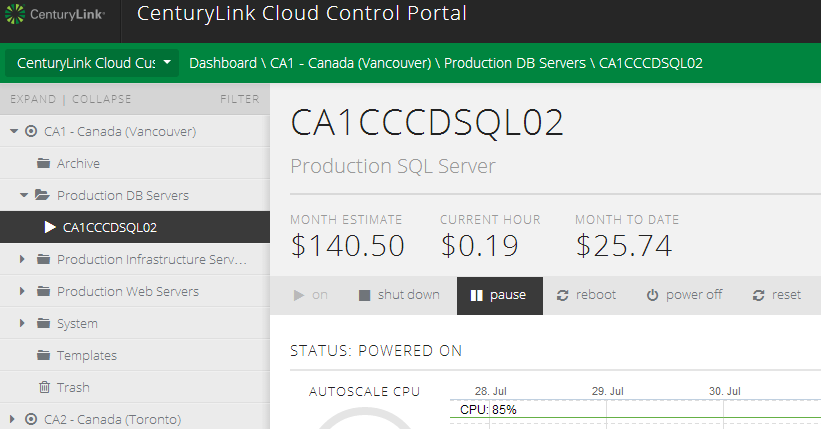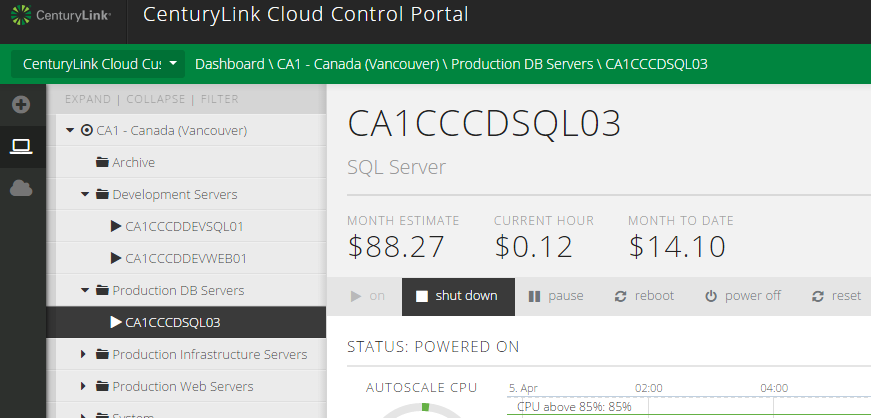Templates
Definition: A Virtual Machine template provides a standardized group of hardware and software settings that can be used repeatedly to create new virtual machines configured with those settings.
How To: How To Create A Customer Specific OS Template
Costs Customer specific template storage is billed on a per GB basis as Standard Storage. Out of the box Virtual Machine templates in the Lumen Cloud platform do not incur a storage fee. Visit our pricing catalog for rates.
Sample Use Case ISV would like to build a virtual machine base template that includes the OS, software packages and security customization to improve speed of delivery to their client base.
Please note Text files stored on user's Desktops will NOT be carried over in the template if they are stored on the C Drive of a windows virtual machine
Clones
Definition Cloning creates an independent, duplicate copy of an existing virtual machine which is nearly identical to the “source” virtual machine. The cloned machine retains the same hardware, operating system, application and configuration items as the original virtual machine; however, certain items, such as the server’s security identifier, are changed during the process. For some further information around cloning, please see Cloning Best Practices
How To: How To Clone A Virtual Machine Instance
Costs As a virtual machine clone is a completely separate copy of a VM, it is billed per hour based on the resources assigned. Visit our pricing catalog for rates.
Sample Use Case IT department needs to reproduce and find a resolution to a software bug that is affecting theircustomers. In order to avoid changes and downtime to the production environment , a clone of the problem virtual machine is created allowing for further troubleshooting without customer impact.
Please note Text files stored on user's Desktops will NOT be carried over in the Clone if they are stored on the C Drive of a windows virtual machine
Snapshots
Definition: A snapshot preserves the state and data of a virtual machine at a specific point in time. The state includes the virtual machine’s power state (for example, powered-on, powered-off, suspended). The data includes all of the files that make up the virtual machine. This includes disks, memory, and other devices, such as virtual network interface cards.
How To: Creating & Managing Server Snapshots
Costs: Snapshots are included as part of the Lumen Cloud platform. Snapshots can be automatically created or deleted using the built in scheduler.
Sample Use Case: IT Department is preparing for the monthly patch release cycle for their Windows servers. For rapid fallback group level snapshots are created against the production environment prior to application of patches.
Pause
Definition: Pausing a virtual machine suspends the operating system. A virtual machines pause or power state can be changed in a rapid fashion.
How To: The Pause function is available at both the group or individual virtual machine details pane. Customers can leverage the built in scheduler to perform automated changes to power states against individual or groups of virtual machines.

Costs: In the pause state, a customer pays for storage consumed by the virtual machine and licensing costs. Compute and memory costs are not levied. All Managed Services costs are Levied in a pause state. Visit our pricing catalog for rates.
Exceptions: Bare Metal servers cannot leverage the pause feature.
Sample Use Case: A customer maintains a development and staging environment for their production workloads. This environment is only used during business hours 8 AM to 8 PM EST. The IT department, in order to save costs, creates a scheduled pause and power on event during off hours. This automated task eliminates CPU & RAM fee's between the 8 PM and 8 AM EST time window for these environments.
Shutdown/Power Off
Definition: Shutting Down (or powering off) a virtual machine performs a graceful (or un-graceful using the power off command) shutdown of the operating system in a controlled way. A virtual machines power state can be changed in a rapid fashion.
How To: The Shutdown/Power Off function is available at both the group or individual virtual machine details pane. Customers can leverage the built in scheduler to perform automated changes to power states against individual or groups of virtual machines.

Costs: In the shutdown/Power Off state, a customer pays for storage allocated to the virtual machine, licensing costs and Managed Application Services. Compute, memory and Managed OS costs are not levied. Visit our pricing catalog for rates.
Exceptions: Bare Metal servers will continue to bill the normal hourly rate regardless of the state of the server
Sample Use Case: A Managed Server customer maintains a development and staging environment for their production workloads. This environment is only used during business hours 8 AM to 8 PM EST. The IT department, in order to save costs, creates a scheduled shutdown event during off hours. This automated task eliminates CPU, RAM and Managed Server fee's between the 8 PM and 8 AM EST time window for these environments.
Archive
Definition: Archiving a virtual machine suspends the operating system and migrates the instance to a significantly cheaper storage tier. Bringing a virtual server out of an archive state can take a few hours.
How to: The Archive function is available in the individual virtual machine details pane. Customers can leverage the built in scheduler to automate migrate of virtual machine in or out of archive.

Costs: In the archive state, a customer pays only for the archival storage consumed by the virtual machine (at a reduced rate). Compute, memory and licensing costs are not levied. Visit our pricing catalog for rates.
Exceptions: Bare Metal and Managed Services customers cannot leverage the Archive feature.
Sample Use Case: The business department has a reporting server that pulls data on a monthly basis from a 3rd party and generates reports for business analysis. This virtual machine is only required for 2 days per month and otherwise is unused. To save costs, the IT department schedules the server to be placed in archive and brought out of archived for operation during just these 2 days of the month.
